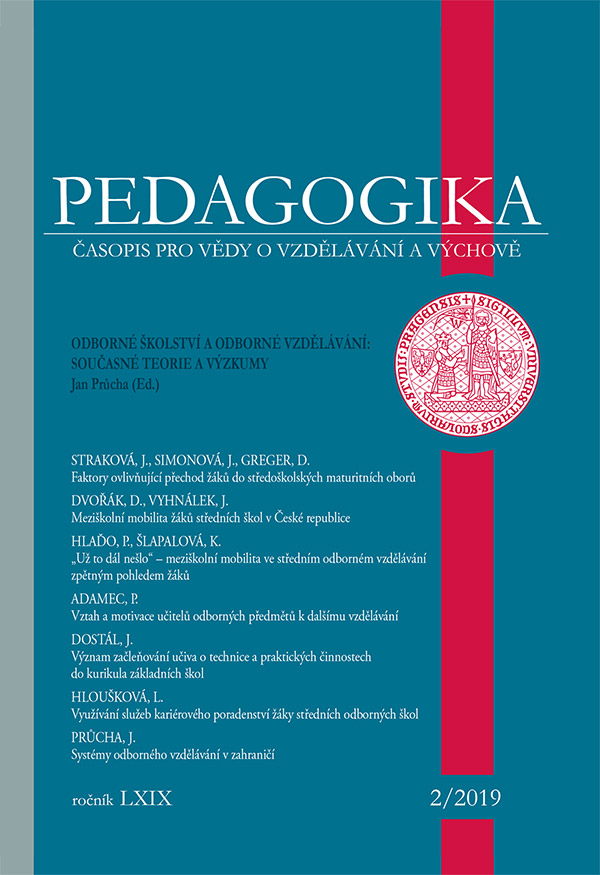“No other Option” – Inter-School Mobility in Middle Vocational Schooling as Seen with Hindsight by Pupils
DOI:
https://doi.org/10.14712/23362189.2018.852Keywords:
inter-school mobility, non-normative transfer, reactive change of school, middle vocational educationAbstract
One current problem in middle vocational education is the growing number of pupils moving between schools. Th e study aims to ascertain the reasons behind reactive non-normative moves by pupils to another middle school, and also to identify the strategies of pupils and their eff ects on inter-school mobility. A qualitative approach was chosen using the methods of focus groups and semi-structured interviews. Th e collection of the data took place in October 2016 and the respondents were 31 pupils who had changed schools at least once in the course of their middleschool education for a reason other than moving house. In the study inter-school mobility is identifi ed and explored as a developmental process with roots that in the case of some students may go back to career decisions made at basic school. Two categories of possible reasons for inter school mobility are described and there is discussion of identifi ed ineff ective pupil strategies that can lead to reactive non-normative moves to another middle schools. Recommendations for teacher practise
are outlined in the conclusion.
References
ČŠI. (2016). Kvalita a efektivita vzdělávání a vzdělávací soustavy ve školním roce 2015/2016. Výroční zpráva České školní inspekce. Praha: Česká školní inspekce.
Dobson, J. (2008). Pupil mobility, choice and the secondary school market: Assumptions and realities. Educational Review, 60(3), 299-314.
https://doi.org/10.1080/00131910802195893
Dupere, V., Archambault, I., Leventhal, T., Dion, E., & Anderson, S. (2015). School mobility and school-age children's social adjustment. Developmental Psychology, 51(2), 197-210.
https://doi.org/10.1037/a0038480
Dvořák, D., & Vyhnálek, J. (2018). Student trajectories in a stratified system: Quantitative study of post-socialist secondary schooling. (Online). Dostupné z https://eera-ecer.de.
Dvořák, D., & Vyhnálek, J. (2019). Meziškolní mobilita žáků středních škol v České republice. Pedagogika, 69(1), 131-146.
Dvořák, D., Vyhnálek, J., & Starý, K. (2016). Tranzice a transfer ve vzdělávací dráze: Longitudinální studie rizikového žáka. Studia paedagogica, 21(3), 9-39.
https://doi.org/10.5817/SP2016-3-2
Finn, J. D. (1989). Withdrawing from school. Review of Educational Research, 59(2), 117-142.
https://doi.org/10.3102/00346543032002117
https://doi.org/10.3102/00346543059002117
Gasper, J., DeLuca, S., & Estacion, A. (2010). Coming and going: Explaining the effects of residential and school mobility on adolescent delinquency. Social Science Research, 39(3), 459-476.
https://doi.org/10.1016/j.ssresearch.2009.08.009
Gasper, J., DeLuca, S., & Estacion, A. (2012). Switching schools: Revisiting the relationship between school mobility and high school dropout. American Educational Research Journal, 49(3), 487-519.
https://doi.org/10.3102/0002831211415250
Gati, I., Krausz, M., & Osipow, S. H. (1996). A taxonomy of difficulties in career decision making. Journal of Counseling Psychology, 43(4), 510-526.
https://doi.org/10.1037/0022-0167.43.4.510
Gibbons, S., & Telhaj, S. (2011). Pupil mobility and school disruption. Journal of Public Economics, 95(9-10), 1156-1167.
https://doi.org/10.1016/j.jpubeco.2011.03.004
Grigg, J. (2012). School enrollment changes and student achievement growth: A case study in educational disruption and continuity. Sociology of Education, 85(4), 388-404.
https://doi.org/10.1177/0038040712441374
Hanushek, E. A., Kain, J. F., & Rivkin, S. G. (2004). Disruption versus tiebout improvement: The costs and benefits of switching schools. Journal of Public Economics, 88(9-10), 1721-1746.
https://doi.org/10.1016/S0047-2727(03)00063-X
Haveman, R., Wolfe, B., & Spaulding, J. (1991). Childhood events and circumstances influencing high school completion. Demography, 28(1), 133-157.
https://doi.org/10.2307/2061340
Haynie, D. L., & South, S. J. (2005). Residential mobility and adolescent violence. Social Forces, 84(1), 361-374.
https://doi.org/10.1353/sof.2005.0104
Hlaďo, P. (2012). Informační zdroje, informace a jejich efektivita při rozhodování žáků středních škol o další vzdělávací a profesní dráze. Liefelong Learning - celoživotní vzdělávání, 2(2), 19-39.
Hlaďo, P., & Ježek, S. (2018). Measurement of career-specific parental behaviors perceived by Czech adolescents. Studia paedagogica, 23(2), 101-135.
https://doi.org/10.5817/SP2018-2-7
Chamoutová, D., Vojtěch, J., & Chomová, P. (2017). Analýza realizované vzdělávací nabídky středních škol. Praha: NÚV.
Lee, V. E., & Burkham, D. T. (1992). Transferring high schools: An alternative to dropping out? American Journal of Education, 100(4), 420-453.
https://doi.org/10.1086/444024
Lepeňová, D., & Hargašová, M. (2012). Kariéra v meniacom sa svete: Kariérová výchova a kariérové poradenstvo pre žiakov. Bratislava: Metodicko-pedagogické centrum.
Lincoln, Y. S., & Guba, E. G. (1985). Naturalistic inquiry: The paradigm revolution. London: Sage.
https://doi.org/10.1016/0147-1767(85)90062-8
Mehana, M., & Reynolds, A. J. (2004). School mobility and achievement: A meta-analysis. Children and Youth Services Review, 26(1), 93-119.
https://doi.org/10.1016/j.childyouth.2003.11.004
Miles, M. B., & Huberman, A. M. (1994). Qualitative data analysis: An expanded sourcebook. Thousand Oaks: Sage.
Patton, W., & McMahon, M. (2014). Career development and system theory: Connecting theory and practice (3. vyd.). Rotterdam: Sense.
https://doi.org/10.1007/978-94-6209-635-6
Pelikán, J. (2011). Základy empirického výzkumu pedagogických jevů. Praha: Karolinum.
Poblete, G. Z., & Madsen, C. M. (2013). ¿Por qué los estudiantes se cambian de escuela? Análisis desde las decisiones familiares. Perfiles Educativos, 35(140), 48-62.
https://doi.org/10.1016/S0185-2698(13)71821-X
Pribesh, S., & Downey, D. B. (1999). Why are residential and school moves associated with poor school performance? Demography, 36(4), 521−534.
https://doi.org/10.2307/2648088
Rumberger, R. W. (2003). The causes and consequences of student mobility. Journal of Negro Education, 72(1), 6-21.
https://doi.org/10.2307/3211287
Rumberger, R. W., Larson, K. A., Ream, R. K., & Palardy, G. J. (1999). The educational consequences of mobility for California students and schools. Berkeley, CA: Policy Analysis for California Education.
Sharkey, P., & Sampson, R. J. (2010). Destination effects: Residential mobility and trajectories of adolescent violence in a stratified metropolis. Criminology, 48(3), 639-681.
https://doi.org/10.1111/j.1745-9125.2010.00198.x
Strauss, A. L., & Corbin, J. (1999). Základy kvalitativního výzkumu: Postupy a techniky zakotvené teorie. Boskovice: Albert.
Švaříček, R. (2005). Je zakotvená teorie teorií? In Sborník prací filozofické fakulty brněnské univerzity U 10 (s. 133-145). Brno: Masarykova univerzita.
Temple, J. A., & Reynolds, A. J. (1999). School mobility and achievement: Longitudinal findings from an urban cohort. Journal of School Psychology, 37(4), 355−377.
https://doi.org/10.1016/S0022-4405(99)00026-6
Vyhnálek, J. (2016). Meziškolní mobilita: přehledová studie výzkumných témat. Orbis scholae, 10(1), 63-96.



